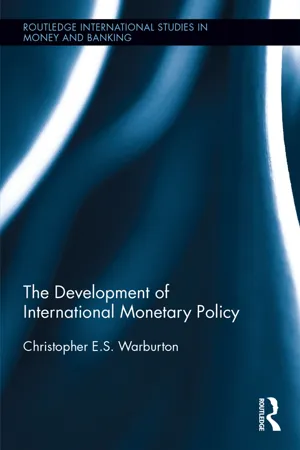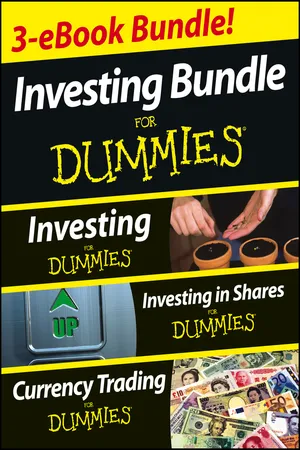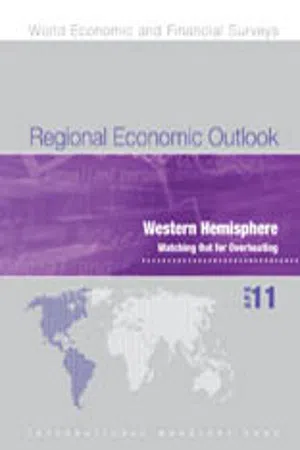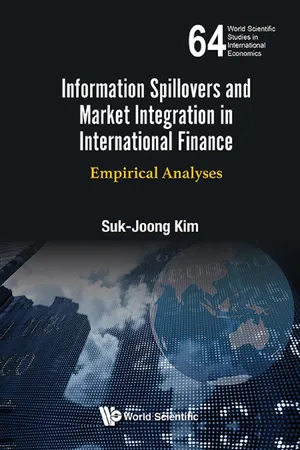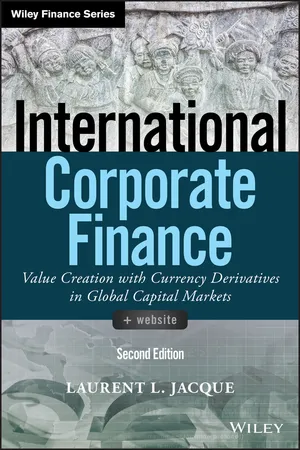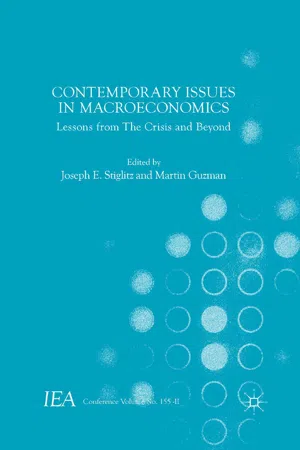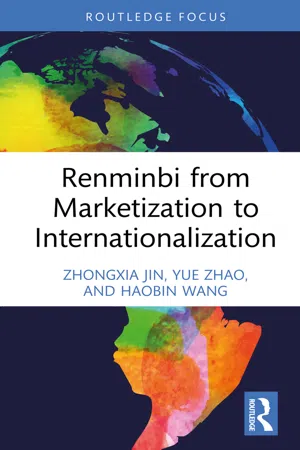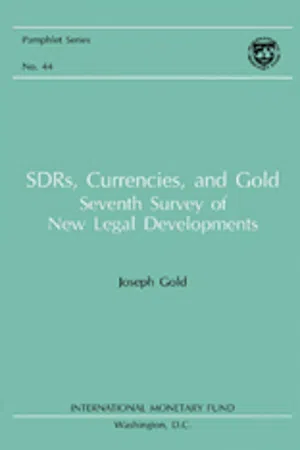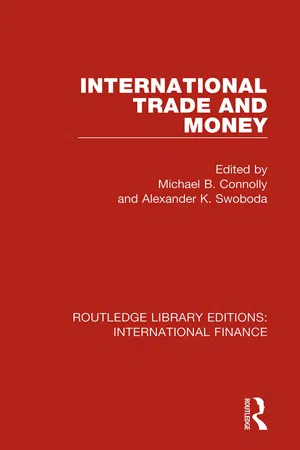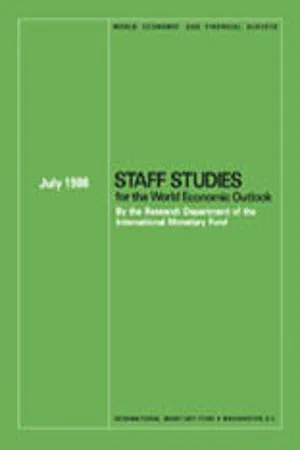Economics
Foreign Exchange Intervention
Foreign exchange intervention refers to the actions taken by central banks or monetary authorities to influence the value of their currency in the foreign exchange market. This can involve buying or selling domestic currency to stabilize exchange rates or address economic imbalances. The goal is to maintain stability and prevent excessive volatility in the currency markets.
Written by Perlego with AI-assistance
Related key terms
12 Key excerpts on "Foreign Exchange Intervention"
- eBook - ePub
- Christopher Warburton(Author)
- 2017(Publication Date)
- Routledge(Publisher)
7 Intervention in foreign exchange markets and the future of fiat moneyIn many ways, this chapter is an extension of Chapter 2 . It analyses the rationale for intervention in foreign exchange markets and the conditions under which intervention can be manipulatory. It also evaluates the viability of fiat money in the distant future, given the emergence of complementary electronic currency. The fundamental properties of money and the relevance of such properties are discussed.What are Foreign Exchange Interventions? Foreign Exchange Interventions are the purchases and sales of foreign currency in foreign exchange markets to attain specific or multiple macroeconomic objectives. Foreign exchange markets are networks of financial institutions and brokers in which individuals, businesses, banks, and governments buy and sell the currencies of different countries. Foreign exchange market participants are generally interested in financing international trade, investing or doing business abroad, or speculating on currency price movements. Different currencies are traded on a daily basis to the tune of about $2 trillion in the FX market around the world.There are two primary types of transactions in the FX market: (a) spot transactions (agreement to buy or sell currency at the current exchange rate) to be settled in about two days, and (b) forward transactions in which traders agree to buy and sell currencies at predetermined exchange rates for settlement in at least three days. Businesses use forward transactions to reduce their exposures to exchange rate risk.Intervention in foreign exchange market is nothing new, but its excesses can be disruptive. Some of the fundamental and concerted reasons for regulating monetary policy were presented in Chapter 2 , paramount of which is the effort to prevent macroeconomic destabilisation. Invariably, the delictual effect of intervention is less precise because sovereign nations are legally permitted to ensure the stability of their economies as long as their methods do not threaten global financial stability. Recall the lawful customary and conventional monetary sovereign rights that were discussed in Chapter 2 - eBook - ePub
- W. Charles Sawyer, Richard L. Sprinkle(Authors)
- 2020(Publication Date)
- Routledge(Publisher)
If an inconvertible currency has become overvalued, the question becomes what the nominal exchange rate “should” be. Recall that domestic residents who possess foreign exchange are legally obliged to surrender it to the government. To a greater or lesser extent, there would be legal sanctions for failing to do this. Suppose that the penalties for illegally possessing foreign exchange are fairly small—say, a small monetary fine. If the currency becomes sufficiently overvalued, it may become logical (although illegal) to not surrender the foreign exchange to the government at the fixed price. Given that there is excess demand for foreign exchange, it is quite possible that you could find a buyer who would be willing to pay more than the fixed government rate. When the government attempts to fix any price, a black market will develop. If one observes that there is a black market for foreign exchange in a country, you don’t even need to ask if there are exchange controls. The very existence of a black market means that the government’s fixed price for foreign exchange is too low. In this case, there are only two remaining questions. First, how overvalued is the official exchange rate? The black market rate is a reliable guide to this. Empirical estimates have shown time and again that the black market rate will closely approximate purchasing power parity. This knowledge is both a blessing and a curse. It is good in the sense that one usually does not have to conduct tedious calculations of just how overvalued the exchange rate is. One can simply go out in the street and find out. However, the answer in some cases may be disheartening. If the black market rate is 50 percent above the official rate, there is likely to be a nasty combination of an austerity program and/or a large devaluation to bring the economy back into balance. Economists will likely be able to identify countries where there is a high probability of a major devaluation. When such a currency crisis will occur is another matter.INTERVENTION IN THE FOREIGN EXCHANGE MARKETAs the previous section illustrated, there are a number of problems associated with a country attempting to “fix” its exchange rate by making its currency inconvertible. As a result, many countries “fix” their currency to the currency of another country using a different method. For example, suppose that Mexico wants to fix (peg) the value of the peso to the U.S. dollar at some exchange rate and does not want to make the peso inconvertible. Mexico can accomplish this by using intervention in the foreign exchange market. Intervention simply refers to the government buying and selling foreign exchange to influence the value of the exchange rate. A country’s central bank usually conducts intervention. When the Mexican government sells foreign exchange, such as U.S. dollars, it increases the supply of foreign exchange in the market. This increase in the supply of dollars causes the exchange rate to change. On the other hand, if the Mexican government buys dollars in the foreign exchange market, this influences the demand for foreign exchange and causes the exchange rate to change. Likewise, any other shift in the demand or supply of foreign exchange also influences the exchange rate and would cause it to change. The “fixing” or “pegging” the value of a country’s currency is illustrated in Figure 18.4 . Suppose that the Mexican government wants to fix or peg the peso against the dollar at a level equal to XRP - David Stevenson, Paul Mladjenovic, Tony Levene, Kathleen Brooks, Brian Dolan(Authors)
- 2013(Publication Date)
- For Dummies(Publisher)
That line is reserved for open market intervention by the central bank, and when it rings, it usually means only one thing: The central bank is intervening in the market. Intervention refers to central banks buying or selling currencies in the open market to drive currency rates in a desired direction. Direct intervention in the market is usually taken only as a last resort. It also may be a stopgap measure to stabilize markets upset by extreme events, such as a terrorist attack or rumors of a financial institution’s failure. When it’s not necessitated by emergency circumstances, markets are generally aware of the increasing risks of intervention. Open market intervention is usually preceded by several less-blunt forms of official intervention. The idea from the government’s point of view is to get as much bang for the buck as possible before committing real money. Remember: Central banks have limited firepower in relation to the overall market, so they have to pick their spots well. Sometimes, the government’s objective is simply to slow a market move to restore financial market stability, and less drastic forms of intervention are not yet necessary. Some of the more subtle forms of intervention are Verbal intervention or jawboning: These are efforts by finance ministry or central bank officials to publicly suggest that current market directions are undesirable. Basically, it amounts to trying to talk up or talk down a particular currency’s value. For example, if the Japanese MOF is intent on preventing further JPY strength to protect its export sector, but the USD/JPY rate keeps moving lower, senior MOF officials may indicate that “excessive exchange rate movements are undesirable.” This message signals currency traders to reduce their USD selling/JPY buying or risk the potential consequences- eBook - ePub
- International Monetary Fund. Western Hemisphere Dept.(Author)
- 2011(Publication Date)
- INTERNATIONAL MONETARY FUND(Publisher)
Figure 3.2 . Intervention has nearly always been in the same direction, but varies greatly in both frequency and intensity across countries. Intervention has been accompanied by exchange rate appreciation in many cases.Source: IMF staff calculations on the basis of central bank data.Note: Latin America includes Costa Rica, Guatemala, and Uruguay. Positive values of intervention refer to purchases, whereas negative values refer to sales. For the sake of completeness, both purchases and sales are depicted. Upward movements of the exchange rate correspond to depreciations. Arrows on the axis denote that the scale has been changed relative to previous and subsequent panels.1 Intervention measured as a percentage of the average annual GDP between 2004 and 2010.2 Some FX operations conducted by Banco de Mexico may not be considered as intervention and show how difficult it is to have a proper definition. In particular, prior to the crisis, the central bank was selling, according to an announced rule, exactly half of the increase in net reserves, which reflected Pemex and the federal government’s law-mandated transfers of their FX receipts to the central bank. The policy adopted by the foreign exchange commission was to reduce the pace of accumulation of international reserves. Actual purchases (through options) have taken place only since March 2010. Option auction data reported.3 Simple averages.Passage contains an image
3.3. Modalities of Intervention
In general, knowledge of the manner in which central banks intervene in FX markets is limited. This is partly because many central banks withhold such information, but also because the country information that is available is dispersed, and the literature on intervention tends to focus on one country at a time. Some studies have examined intervention practices through surveys, aiming at drawing lessons on best practices (Neely, 2008 , 2001; Bank for International Settlements, 2005 ; Shogo and others, 2006 ; and Canales-Kriljenko, 2003 ).7 - eBook - ePub
Strained Relations
US Foreign-Exchange Operations and Monetary Policy in the Twentieth Century
- Michael D. Bordo, Owen F. Humpage, Anna J. Schwartz(Authors)
- 2015(Publication Date)
- University of Chicago Press(Publisher)
In the short run, intervention often generates losses, a point that Goodhart and Hesse (1993) also illustrate. Hence, it is possible that technical traders profit against central banks in the short run while central banks profit in the long term. This raises questions about the effect that sustained intervention might have on the functioning of private foreign-exchange markets. 25 1.7 Road Map This chapter has presented background material on foreign-exchange intervention and on the US institutional framework for that intervention. The remainder of this book explains how theories of intervention and institutional arrangements evolved in the United States, primarily during the twentieth century. The key concern is how these developments interacted with monetary policy. As chapter 2 explains, precedents for modern foreign-exchange-market operations are found in European experience with the classical gold standard, but they quickly grew and developed after World War I as countries first attempted to return to the gold standard and then reacted to the Great Depression. European central banks under the classical gold standard often bent the “rules of the game” through discount policies and gold devices. These were early exchange-market operations. Some European central banks held foreign-exchange reserves and stabilized their exchange rates within the gold points through intervention. Chapter 2 illustrates early uses of secrecy, sterilization, and forward transactions—all of which become important characteristics of modern interventions. The chapter also discusses the establishment of the British Exchange Equalisation Account, which directly intervened in the foreign-exchange market. American antecedents also aided the development of foreign-exchange operations in the United States. Chapter 2 explains the rise of private firms that specialized in the spatial and temporal arbitrage of sterling bills and related instruments - eBook - ePub
Information Spillovers and Market Integration in International Finance
Empirical Analyses
- Suk-Joong Kim(Author)
- 2017(Publication Date)
- WSPC(Publisher)
However, official interventions by the BOJ were ineffective at best and market disturbing at worst prior to 1995. Specifically, a Yen purchase (sale) was associated with a Yen depreciation (appreciation) on the day of intervention which might lead to an erroneous conclusion of intervention ineffectiveness. There has also been some evidence that interventions were associated with an increase in foreign exchange volatility, and consequently, had an adverse effect of destabilising the market (Beine, 2004; Nagayasu, 2004; Frenkel et al., 2005). Over recent years, the BOJ has been claimed to have intervened mostly in a secret manner. Beine and Bernal (2007) report that about 80% of total transactions during 2003–2004 were not publicly known at the time of intervention. A secret intervention is executed in such a way that allows a central bank to influence the exchange rate without sending any signal about its presence in the market. Previous literature has suggested that a central bank will opt to intervene covertly for many reasons. First, there may be occasions where there is a need to intervene to correct a current trend in exchange rate movements but such a move would contradict the current monetary policy objective. Such a misalignment in policy objectives would require a secret Foreign Exchange Intervention so as to achieve the foreign exchange aim without losing a monetary policy credibility (Chiu, 2003). Second, if the bank experiences a low level of credibility or there is a record of past failures in influencing the currency (Dominguez and Frankel, 1993), publicly known interventions, unless they are substantially large and repeated (and possibly coordinated with other central banks) may not achieve desired outcomes as market will not value the information contained in the intervention - eBook - ePub
International Corporate Finance
Value Creation with Currency Derivatives in Global Capital Markets
- Laurent L. Jacque(Author)
- 2019(Publication Date)
- Wiley(Publisher)
ex post basis from variations in the level of central banks' foreign exchange reserves.- In a system of stabilized exchange rates, the central bank is contractually committed to maintaining the prevailing exchange rate within a narrow, publicly defined band of fluctuations. Clearly, uncertainty about future spot exchange rates is, barring a major devaluation or revaluation, the reason this system is often referred to as a system of “pegged yet adjustable” exchange rates, bounded from the standpoint of market participants.
- Under a system of controlled exchange rates, the central bank supersedes the marketplace by becoming the sole buyer and seller of foreign exchange. The rate at which transactions take place is no longer determined by the interaction of supply and demand forces; rather, it is the end product of bureaucratic decisions. Furthermore, buying and selling rates are not necessarily identical, nor are selling and buying rates uniform across all foreign exchange earnings or payments-generating transactions.
QUESTIONS FOR DISCUSSION
- What is the difference between a “clean” float and a “dirty” float?
- Why do countries intervene in their foreign exchange markets?
- What is the difference between currency convertibility and exchange rate flexibility?
- Explain how central bank intervention allows a country to keep its forex rate at a certain level.
- What is the difference between central bank intervention in the foreign exchange market in the context of floating versus stabilized exchange rates?
- How would you contrast a controlled exchange rate with a stabilized exchange rate?
- What does the explosive growth in China's reserves tell you about the nature of its exchange rate regime?
- The last time the U.S. Federal Reserve Bank intervened in the forex market was in 1995. Would you expect the U.S. foreign exchange reserves to have increased or decreased over the past 18 years?
- eBook - ePub
Contemporary Issues in Macroeconomics
Lessons from The Crisis and Beyond
- Joseph E. Stiglitz, Joseph E. Stiglitz, Kenneth A. Loparo, Joseph E. Stiglitz, Martin Guzman(Authors)
- 2016(Publication Date)
- Palgrave Macmillan(Publisher)
Bangko Sentral Review, vol. V, pp. 1–25.Adler, Gustavo, and Camilo E. Tovar (2011) “Foreign Exchange Intervention: A Shield Against Appreciation Winds?,” IMF Working Paper No. 11/165. Barabás, Gyula (2003) “Coping with the Speculative Attack Against the Forint’s Band,” MNB Background Studies, 2003/3.Disyatat, Piti, and Gabriele Galati (2005) “The Effectiveness of Foreign Exchange Intervention in Emerging Market Countries,” Foreign Exchange Market Intervention in Emerging Markets, BIS Paper no. 24, pp. 97–113.Domaç, Ilker, and Alfonso Mendoza (2004) “Is There Room for Foreign Exchange Interventions Under an Inflation Targeting Framework? Evidence from Mexico and Turkey,” World Bank Policy Research Working Paper No. 3288, April.Ghosh, Atish R. (1992) “Is it Signaling? Exchange Intervention and the Dollar-Deutschemark Rate,” Journal of International Economics, vol. 32, nos 3–4, pp. 201–20.GuimaraÞes-Filho, Roberto F., and Cem Karacadag (2004) “The Empirics of Foreign Exchange Intervention in Emerging Market Countries: the Cases of Mexico and Turkey,” IMF Working Paper 04/123. Holub, Tomáš (2004) “Foreign Exchange Interventions Under Inflation Targeting: The Czech Experience,” Czech National Bank Internal Research and Policy Notes, No. 1, Czech National Bank, January.Jeanne, Olivier, and Andrew K. Rose (2002) "Noise Trading and Exchange Rate Regimes," Quarterly Journal of Economics, vol. 117, no. 2, pp. 537–69.Kamil, Herman (2008) “Is Central Bank Intervention Effective Under Inflation Targeting Regimes? The Case of Colombia,” IMF Working Paper 08/88. Mandeng, Ousmène (2003) “Central Bank Foreign Exchange Market Intervention and Option Contract Specification: The Case of Colombia,” IMF Working Paper O3/135.Ostry, Jonathan D., Atish R. Ghosh, Karl Habermeier, Marcos Chamon, Mahvash S. Qureshi, and Dennis B. S. Reinhardt (2010) “Capital Inflows: The Role of Controls,” IMF Staff Position Note 10/04 (Washington, DC: International Monetary Fund).Ostry, Jonathan D., Atish R. Ghosh, Marcos Chamon, and Mahvash S. Qureshi (2011) “Capital Controls: When and Why?,” IMF Economic Review - Zhongxia Jin, Yue Zhao, Haobin Wang(Authors)
- 2022(Publication Date)
- Routledge(Publisher)
1 The Macroeconomic Impact of Foreign Exchange InterventionCross-Country Empirical StudiesDOI: 10.4324/9781003305668-1The Macroeconomic Impact of Foreign Exchange Intervention: Background and Methodology
Mainstream views regarding the optimal choice of exchange rate policies have evolved over time, and the issue is still a matter of significant debate. In the early 1990s, a fixed exchange rate (pegged to the US dollar or German mark) was a popular option for developing countries, especially those transitioning toward market economies. However, the capital account crises and exchange rate collapse that took place in the late 1990s revealed the vulnerability of a fixed exchange rate and resulted in the wide perception that simple pegs might be too risky and that a country should either adopt a hard peg via monetary unions or currency boards, or use a free-floating exchange rate without government intervention (Ghosh and Ostry, 2009 ).The collapse of the Argentine peso in 2002 once again shifted mainstream views with regard to the optimal choice of an exchange rate regime by raising new doubts about the viability of hard pegs. Discussions about the merits of an intermediate exchange rate regime followed suit. Yi and Tang (2001) proposed an expanded version of the “impossible trinity” and showed that a country does not have to fully give up any one of the trinity conditions (i.e., a fixed exchange rate, free capital mobility, or monetary independence). The authors argued that it is possible to achieve a combination of the three conditions proportionately. Their proposal suggested that an exchange rate regime does not necessarily have to be a clean float or a hard peg, but in practice, can be an intermediate regime that lies in between the two.Husain et al. (2005) found that exchange rate regimes across countries have not exhibited an obvious tendency to evolve toward either a clean float or a hard peg. Instead, intermediate regimes have demonstrated greater sustainability over time. They also found that the merits of a free-floating regime tend to become more prominent as an economy matures. In the early stage of economic development, a fixed exchange rate has the benefit of serving as a nominal anchor that keeps inflation in check. However, as an economy matures and its policy credibility improves, the price-stabilizing function of a fixed exchange rate becomes less important. A free-floating regime, on the other hand, appears more beneficial as mature economies with a free-floating exchange rate tend to achieve superior economic performance. The 2009 International Monetary Fund (IMF) review of exchange rate regimes similarly pointed out that the appropriate choice of exchange rate regime should depend on country-specific contexts: A rigid exchange rate regime helps anchor inflation expectations and sustain economic output, but simultaneously puts greater constraints on macroeconomic policies, increases vulnerability to crises, and impedes macroeconomic adjustments against external shocks (Ostry and Ghosh, 2009- Joseph Gold(Author)
- 1987(Publication Date)
- INTERNATIONAL MONETARY FUND(Publisher)
a. The achievement of greater exchange rate stability, which does not imply rigidity, is a major objective and commitment of our countries.b. The path to greater exchange rate stability must lie in the direction of compatible mixes of policies supporting sustainable noninflationary growth. This will be the primary objective of a strengthened multilateral surveillance as agreed in Versailles.c. In the formulation of our domestic economic and financial policies, our countries should have regard to the behavior of our exchange rates as one possible indication of need for policy adjustment. Close attention should also be given to the interactions and wider international implications of policies in each of our countries.d. Under present circumstances, the role of intervention can only be limited. Intervention can be useful to counter disorderly market conditions and to reduce short-term volatility. Intervention may also on occasion express an attitude toward exchange markets. Intervention will normally be useful only when complementing and supporting other policies. We are agreed on the need for closer consultations on policies and market conditions; and, while retaining our freedom to operate independently, are willing to undertake coordinated intervention in instances where it is agreed that such intervention would be helpful.91On January 17, 1985, the Ministers of Finance and the Central Bank Governors of the Group of Five major industrial countries (France, the Federal Republic of Germany, Japan, the United Kingdom, and the United States) held a meeting as one of the series of periodic consultations among these countries on economic and financial matters of common interest. The Managing Director attended for a discussion of the economic policies and prospects of these major industrial countries. The Ministers and Governors expressed their commitment to work toward greater exchange market stability.92- eBook - ePub
- Michael B. Connolly, Alexander K. Swoboda(Authors)
- 2018(Publication Date)
- Routledge(Publisher)
PART IIIINTERNATIONAL MONETARY ANALYSIS
Passage contains an image
I. INTRODUCTION7
A Model for the Analysis of Official Intervention in the Foreign Exchange Markets
GIORGIO BASEVI
University of LouvainandUniversity of BolognaThis study has three main objectives. The first is to provide a framework for analysing the internal monetary effects of surpluses and deficits in the balance of a country’s international payments. In published models of the foreign exchange markets, both theoretical2 and empirical,3 there typically is no link between the determination of exchange rates, on the one hand, and interest rates on the other. Yet, capital movements are described and estimated, in these models, as determined by the joint influence of such variables. This missing link might very well go far toward explaining the weak statistical results that are generally obtained in these models, especially with regard to the sensitivity of capital movements to exchange rates or to covered interest rate differentials. Even in the economy-wide models that have been constructed and estimated for various countries in recent years, the channels through which external surpluses (deficits) inject (absorb) liquidity into (from) the economy is not clarified in a detail sufficient for the analysis of the connections between foreign exchange policy and monetary policy.The second objective of this study is to provide a framework for analysing the foreign exchange market in all its sections; mainly those determining the spot and forward rates, but in principle also those determining the rates for various maturities of forward exchange contracts. In estimated macroeconomic models only the spot exchange rate is endogenous, while forward rates usually are either ignored or exogenous.4 - eBook - ePub
- International Monetary Fund(Author)
- 1986(Publication Date)
- INTERNATIONAL MONETARY FUND(Publisher)
A second issue is whether the exchange rate movement itself resulted from a policy shift or from a shift in private market behavior. As described above, the economic consequences of the exchange rate movement depend critically on its source. And third, the timing of the change may be quite important. Short-term fluctuations in exchange rates may be disruptive, but they do not in general call for changes in economic policies. The postwar experience with short-term adjustments to monetary and fiscal policies has not led to favorable conclusions; on the contrary, the importance of maintaining a medium-term perspective on policy settings is now widely accepted. Nonetheless, large sudden movements in exchange rates may be more disruptive than slower adjustments and may require a relatively large, though possibly temporary, policy response. Each of these issues is discussed further below.Another point to be kept in mind is that a policy reaction to a change in conditions brought about by (or associated with) exchange rate movements is not the same as using policy to stabilize exchange rates. In a sense, one could regard a fixed exchange rate system—such as the European Monetary System—or a system of “target zones” for exchange rates as a means of systematizing policy responses to exchange rate changes, or rather to changes in conditions that give rise to exchange rate movements. Nonetheless, even if the authorities have no exchange rate objective at all, they are unlikely to be indifferent to shifts in output, prices, or current account balances that are associated with these changes. For example, the rate of monetary growth that is appropriate under initial conditions may no longer be appropriate after an exchange rate depreciation alters the path of the current account balance and (at least temporarily) both output and inflation.A final general point to be made is that the policy reactions considered in this section are limited to shifts in monetary or fiscal policies. In some circumstances, sterilized intervention might be considered as an additional policy tool, especially if the exchange rate movements were thought to be temporary and unrelated to shifts in underlying economic and financial conditions. However, the focus of this paper is on the consequences of large sustained movements in exchange rates, and it is unlikely in this context that sterilized intervention could play more than a very limited subsidiary role (see Jurgenson (1983)). Other policy actions, including those designed to improve labor productivity or otherwise improve the functioning of the supply side of the economy, would not generally be appropriate responses to the kinds of shocks being discussed here. Such policies may well be warranted, but their desirability would probably not be affected one way or the other by movements in exchange rates.
Index pages curate the most relevant extracts from our library of academic textbooks. They’ve been created using an in-house natural language model (NLM), each adding context and meaning to key research topics.
